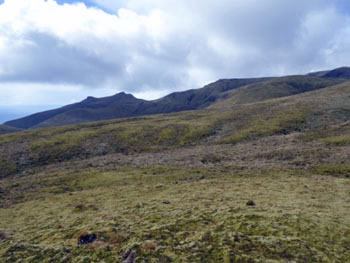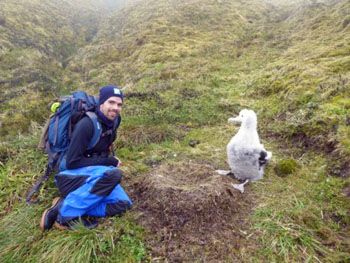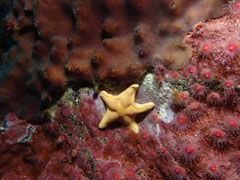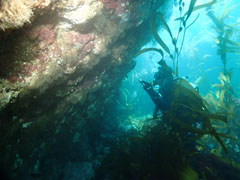2014 News
|
||||||||||||||||
|
||||||||||||||||
Restoring Gough Island's Environment An update from Tristan Administrator Alex Mitham February 2014 A mountainous island of volcanic origin, eight miles by four, at 40°19S 9°55W, 220 miles south east of the other islands in the Tristan da Cunha Archipelago, it forms a part of the UK Overseas Territory of St Helena, Ascension Island and Tristan da Cunha. Gough is uninhabited, except for a team of six South African meteorologists who each spend a year monitoring weather patterns which affect Southern Africa; scientists have also been based there at times over the past seven years. Tristan da Cunha, the nearest populated island, is the most remote inhabited island in the world. Research is taking place to enable the natural environment of this remote island in the South Atlantic to be restored and to prevent the extinction of a species of albatross and other birds and creatures. The population of the Tristan Albatross (Diomedea dabbenena), and Gough Bunting (Rowettia goughensis), some species of burrowing seabirds and invertebrates, flightless moths, may face extinction because of predation by more than a million house mice. The mice are descendants of those which came ashore (possibly with seal hunters) more than a century ago. The mice are known to feed on berries, seeds, insects and birds’ eggs during the island's summer months and to live in vegetation which dangles from cliffs and gulleys. In winter, lack of alternative food forces them to eat the chicks of the albatrosses and other seabirds and it has become evident from recent surveys that they also threaten the Gough bunting and the island’s endemic flightless moths. Without eradicating the mice, albatrosses and other seabirds risk becoming extinct. For more than a decade, the Royal Society for the Protection of Birds (RSPB), The Tristan da Cunha Government, the UK Government and the University of Cape Town’s Percy Fitzpatrick Institute, have been researching the most effective way to rid Gough of mice. The island has no airport or harbour and is prone to adverse weather conditions in one of the most remote locations on the planet, some 1,700 miles from South Africa and 2,000 miles from South America. Proposals for eliminating mice on Gough have been based on methods used elsewhere in the world to eradicate invasive species from island locations, without interfering with or affecting local indigenous species. The research on Gough has included test flights of helicopters which have the capability to drop bait with the objective of eliminating all the mice, as well as testing whether there are mice resident in the many caves on Gough, and whether or not all mice will eat the type of bait likely to be used. Adding to the complexity of any eradication attempt will be the requirement to hold captive populations of the two endemic land-birds (Gough bunting and Gough moorhen) for the duration of the operation. Tristan Administrator, Alex Mitham, who has just spent time on Gough with Tristan Conservation workers and South African RSPB field workers, who are monitoring Gough’s seabirds, said: “The population of the Tristan albatross continues to decline and the restoration of Gough's environment is an essential starting point to reverse the Tristan albatross decline and prevent extinction. However the challenges – and costs – are huge. We still have much more work to do before the relevant organisations can make an informed decision on when and whether we can go ahead. Calculating the costs and the time-scale, to ensure that Gough Island is returned to the birds and other indigenous creatures which populate this unique place on our planet, is of fundamental importance”. See also RSPB Tristan da Cunha Islands projects on: www.rspb.org.uk/ourwork/tristan-da-cunha-programme |
||||||||||||||||
Tragic Death of Gough Island Radio Operator The South African Department of Environmental Affairs are in contact with his family and are currently arranging a vessel for Johan's repatriation to South Africa. Governor Capes and myself wish to express our deepest condolences to his family at this time. I know that Johan was well known and liked by all the Islanders on Tristan. This is a tragic event, and the whole community have been deeply shocked. He was a young man in the prime of his life, with everything to look forward to. I know all our thoughts are with his family. Alex Mitham, together with members of the Tristan Conservation Department and three Marine Biologists, returned from a three week visit to Gough Island aboard MV Edinburgh on Saturday 15th February. |
||||||||||||||||
Administrator visits Gough Island and experiences the 'Roaring Forties' |
||||||||||||||||




